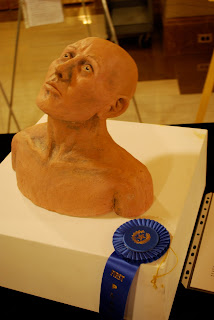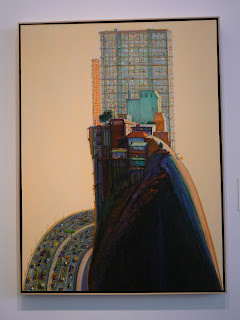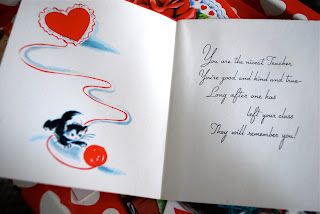Today is Grant Wood's birthday and his painting, American Gothic from 1930 was the inspiration for this lesson.
Day 1: I asked the students to raise their hands if they have ever seen the painting before. Next, I called on students to describe the painting (at this level, name things they see in the picture.) I ask the students who they think the people are and what their relationship is. (Do you think they are friends or family? Husband/wife, brother/sister, father/daughter?) After the students have shared their ideas, I told them about Grant Wood and the painting.
Background info on the painting: Grant Wood was born in Iowa in 1891. Wood grew up on his family’s farm where his interest in art developed. Wood began selling paintings in high school to make money for art supplies and attended the Handicraft Guild art school in Minneapolis and the Art Institute of Chicago after graduating. He joined the army as a camouflage painter and afterwards traveled to Europe to study art. Grant Wood said “I realized that all the really good ideas I’d ever had came to me while I was milking a cow. So I went back to Iowa.” Returning to Iowa was very important in Wood’s career. He decided to paint the landscapes and the people he was most familiar with. This made Wood part of a movement known as Regionalism that some consider the first uniquely American art style. The story behind the painting is that Wood was traveling through Eldon, Iowa when he saw a farmhouse with an unusual window. He had a photograph made of the house so that he could work on the painting in his studio. Wood’s sister, Nan, and his dentist posed for the painting as a farmer and his daughter.
I wanted this project to be about home and family instead of parodies. Basically, the painting is a picture of a family in front of their home! After the Art History lesson, ask students the "big questions":
-What is a family? (Ask what IS instead of what MAKES unless you want to hear about having babies...) Are all families the same? Art pets part of the family? -What makes a house a home? What are some different kinds of homes?
Then I told the students that their assignment would be to make a picture of their family in front of their home. At this stage, I gave the students 9x12 inch white paper and pencils. I reminded the students not to color anything in with pencil because we would be painting in the next class.
Day 2: Pass out drawings, go over paint brush care, painting procedures, roll up sleeves and remind the students to be VERY careful! (I need to acquire some paint shirts!) I wanted to show the Young Sloppy Brush video but I can't seem to find it online ANYWHERE. It must have been taken off of all the websites for some reason. I used tempera cakes and gave the students the smallest paint brushes I had in the classroom to encourage detail work and to make sure they took longer than 2 minutes to paint. Most of the students used the entire class period to paint. A few finished early and were given free draw paper. I have back to back classes and obviously that doesn't leave any time to switch out supplies in between. When my second class came in, I had them sit on the line made from red duct tape (the farmer's almanac told me that either "duct" or "duck" is correct!) where they line up at the end of class while I switched out water and reviewed the Art History lesson from Day 1.
Day 3: I showed the students how to use a marker (either sharpie or black felt tip pen) to trace back over their initial drawn lines and bring out the details of the picture. Markers were the finishing touch and it worked really well for students who missed the class we painted. I didn't think it would work to get out paint just for a student or two who had been absent so I had them trace their pencil lines and use crayon to color in their pictures.
Here are some of my student examples. We all really enjoyed this project, and I'm guessing that their families will appreciate the results!
(One of my Pre-K students that comes with Kindergarten to art.)


















































